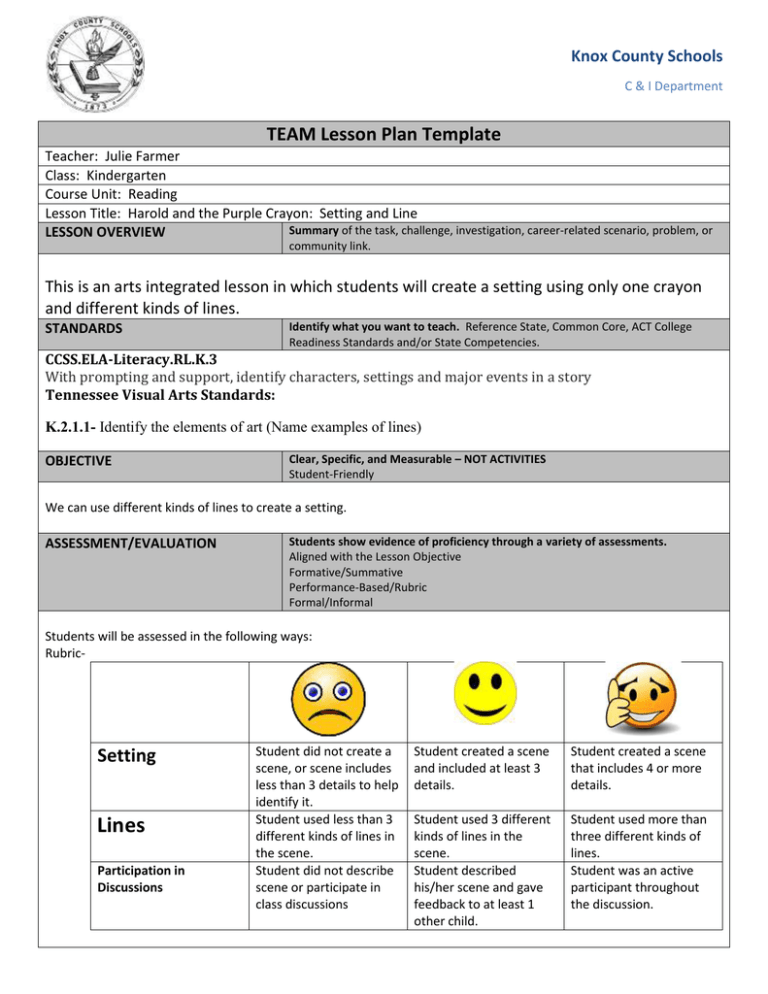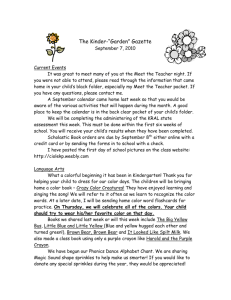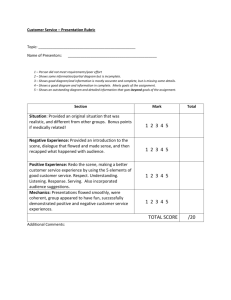Knox County Schools - Arts Education Tennessee Arts Education
advertisement

Knox County Schools C & I Department TEAM Lesson Plan Template Teacher: Julie Farmer Class: Kindergarten Course Unit: Reading Lesson Title: Harold and the Purple Crayon: Setting and Line Summary of the task, challenge, investigation, career-related scenario, problem, or LESSON OVERVIEW community link. This is an arts integrated lesson in which students will create a setting using only one crayon and different kinds of lines. STANDARDS Identify what you want to teach. Reference State, Common Core, ACT College Readiness Standards and/or State Competencies. CCSS.ELA-Literacy.RL.K.3 With prompting and support, identify characters, settings and major events in a story Tennessee Visual Arts Standards: K.2.1.1- Identify the elements of art (Name examples of lines) OBJECTIVE Clear, Specific, and Measurable – NOT ACTIVITIES Student-Friendly We can use different kinds of lines to create a setting. ASSESSMENT/EVALUATION Students show evidence of proficiency through a variety of assessments. Aligned with the Lesson Objective Formative/Summative Performance-Based/Rubric Formal/Informal Students will be assessed in the following ways: Rubric- Setting Lines Participation in Discussions Student did not create a scene, or scene includes less than 3 details to help identify it. Student used less than 3 different kinds of lines in the scene. Student did not describe scene or participate in class discussions Student created a scene and included at least 3 details. Student created a scene that includes 4 or more details. Student used 3 different kinds of lines in the scene. Student described his/her scene and gave feedback to at least 1 other child. Student used more than three different kinds of lines. Student was an active participant throughout the discussion. Knox County Schools C & I Department MATERIALS o o o o o o Aligned with the Lesson Objective Rigorous & Relevant Dry erase board/easel (for teacher) Dry erase markers Student dry erase boards crayons white construction paper Book- Harold and the Purple Crayon by Crockett Johnson ACTIVATING STRATEGY Motivator/Hook An Essential Question encourages students to put forth more effort when faced with a complex, open-ended, challenging, meaningful and authentic questions. What if you could create your own world? What would it look like? INSTRUCTION Step-by-Step Procedures-Sequence Discover/Explain – Direct Instruction Modeling Expectations – “I Do” Questioning/Encourages Higher Order Thinking Grouping Strategies Differentiated Instructional Strategies to Provide Intervention & Extension Direct Instruction “I Do” Review the definition of setting (where and when the story takes place) Read Harold and the Purple Crayon Return to first page of the story and model how to identify the setting. Point out details that offer “clues” to the setting. See “We Do” section below for picture walk Explain the definition of line. (a line is a dot that moves through space) Show examples of different types of lines in the story. (a bumpy line can become the waves in the ocean) Model on dry erase board how to make different kinds of lines (straight, curvy, zig-zag, dotted, etc.) See “We Do” section below for student line practice. Have students close their eyes and imagine the setting they would like to create. What do they see? Hear? Smell? Touch? Taste? Go to “You Do” section for student creation of scenes. Go to “Closure” section for Accountable Talk discussion. Questioning What is a setting? What settings did you notice in this story? How do you know that was the setting? What clues do you see? What is a line? (a dot that moves through space) How many different kinds of lines can you make? Grouping The lesson will begin whole group. Knox County Schools C & I Department Students will share their practice lines with a partner. Partners will tell one thing they noticed and one thing they liked. Students will create their scenes individually at their seats. At the closing of the lesson, students will participate in Accountable Talk as a whole group. Intervention If students have trouble creating different lines, hold their hands and create some lines with them. Extension Have students imagine a problem that could occur in their setting (i.e. at the zoo, a tiger could escape). What could they draw with their crayon to solve the problem? (like when Harold drew a boat to get out of the water) GUIDED & INDEPENDENT PRACTICE “We Do”-“You Do” Encourage Higher Order Thinking & Problem Solving Relevance Differentiated Strategies for Practice to Provide Intervention & Extension We Do: After reading the book, take a picture walk and engage students in a discussion of the different settings and the details in each illustration that help to identify the setting. After modeling how to make different lines, pass out dry erase boards and markers and have students practice making lines and share them with a partner. Students will tell their partner one thing they noticed about the partner’s lines and one thing they liked. You Do: Students will choose one crayon (color of their choice) and create a setting on construction paper using different kinds of lines. Students will include at least 3 details that help the reader identify the setting. CLOSURE Reflection/Wrap-Up Summarizing, Reminding, Reflecting, Restating, Connecting Students will share their creations with the group and discuss their settings and the lines they used to create them. Classmates will give each other feedback using Accountable Talk moves (i.e. “I notice that you used _____ lines in your setting”, “I can tell what your setting is because you included ____”, “Your setting is like mine/different from mine because…”, “I wonder….”, “I think you could include a _____ in your setting”). The rubric will be shown and explained to students to assist them in giving feedback. CROSS-CURRICULAR CONNECTIONS Visual Arts Knox County Schools C & I Department NOTES: I typically teach this lesson after students have already been introduced to the concept of setting.






